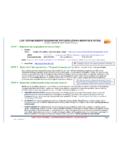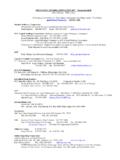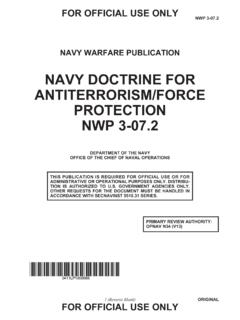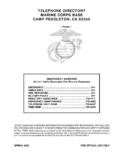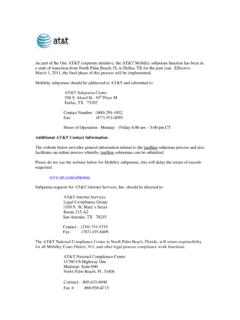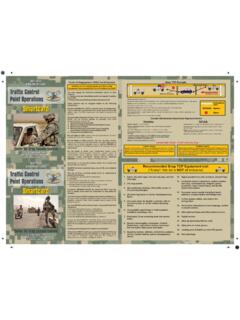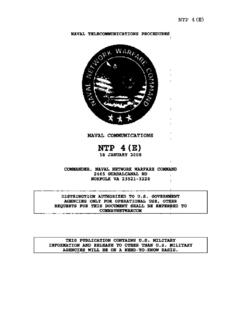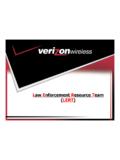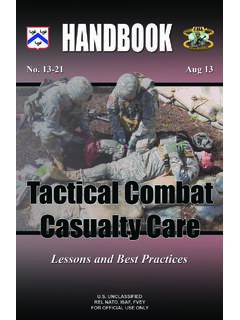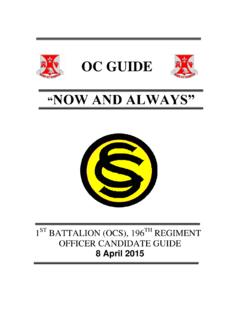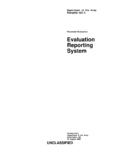Transcription of Army PR Chain Teaching Program - Public …
1 army PR Chain Teaching Program Talking points/supporting notes FOR OFFICIAL USE ONLY FOR OFFICIAL USE ONLY FOR OFFICIAL USE ONLY Key Tenets talking points FOR OFFICIAL USE ONLY 1 Key Tenets Talking Points (Supporting Notes) PR definition. Individuals not specifically addressed within this definition may be included in our PR responsibilities at the direction of the Secretary of Defense (SECDEF). This expands army PR responsibilities considerably as multinational partners, American civilians, and citizens from other nations in our operational areas now become potential recovery obligations for the army . IMDC personnel definition. We are not concerned solely with the recovery of Soldiers; army civilians and contractors are also included in our PR responsibilities. Positive control (DOD) A method of airspace control that relies on positive identification, tracking, and direction of aircraft within an airspace, conducted with electronic means by an agency having the authority and responsibility therein.
2 See FM 3-52. ( army ) Requires commanders and leaders to actively assess, decide, and direct forces within their areas of operation. (FM 6-0). Procedural control (DOD) A method of airspace control which relies on a combination of previously agreed and promulgated orders and procedures. See FM 3-52. ( army ) Using a combination of previously agreed and promulgated orders, regulations, policies, doctrine, and tactics, techniques, and procedures to regulate forces and execute missions. (FM 6-0). PR philosophy. An effective PR capability also increases force morale by demonstrating that we will employ every effort possible to recover our IMDC personnel. PR C2. PR must be embedded within existing C2 systems, not tacked on as an afterthought. This includes all OPLANs/OPORDs, SOPs, policies, etc army PR system. The army PR system, like the army Operations Process, is composed of interdependent components; a change occurring in one area affects others.
3 PR Planning. PR must be embedded throughout our planning processes, both the MDMP and TLP. PR Preparation. PR preparation occurs throughout the mobilization, deployment, employment, sustainment, and redeployment activities of operations. It is not a static task that is only completed at home station. PR Execution. The five PR execution tasks are central to any PR mission. Report. Reports can be generated by an accountability mechanism, visual sightings, intelligence, surveillance, and reconnaissance operations, or communications with an IMDC person reporting the event. Several reports may come from different reporting sources. Locate. Location efforts, using all necessary means, begin with the initial report and continue until recovery is complete. FOR OFFICIAL USE ONLY Key Tenets talking points FOR OFFICIAL USE ONLY 2 Support. Support to IMDC personnel includes establishing communications, authenticating IMDC identities, conducting resupply, maintaining their morale, and protecting them.
4 Support to families includes preparing them for potential media interaction and providing other support to reduce their anxiety and possible frustration during recovery activities. Recover. The recover task does not end until the IMDC personnel are handed over by the recovery element to medical personnel for reintegration. The mere presence of IMDC personnel in a recovery vehicle does not mean the recover task is complete. Reintegrate. The reintegrate task is dependent on the individual circumstances of each recovered person. Reintegration ends when the individual is returned to duty and requires no further care relating to the IMDC event. PR Assessment. Assessment by itself is not sufficient. If we identify best practices or problem areas and don t make appropriate adjustments, assessment will be ineffective. We want incorporated lessons learned, not lessons observed that sit on a shelf.
5 Constantly collect observations and assess; what could go wrong? What could we do better? PR Options. The PR options are not nice, neat boxes that we use to segment PR responsibilities. The Military, Diplomatic, and Civil recovery options are complimentary and may be used in combination. They are not necessarily mutually exclusive. Military. This is the option we have the most control over. Consequently, this is where we focus most of our efforts. Immediate recovery. Immediate recovery assumes that the tactical situation permits a recovery with the forces at hand without detailed planning or coordination. Deliberate Recovery. Weather, enemy actions, IMDC personnel location, and recovery force capabilities are examples of factors that may require the detailed planning and coordination of a deliberate recovery. External supported recovery. Close Air Support, ISR, and airborne C2 are examples of capabilities that may be required from different components to execute an ESR.
6 This method of recovery is inherently complex and requires close coordination among the supporting elements to avoid confusion during the recovery mission. Many PR missions will use this method they are often Joint efforts. Unassisted recovery. Even as IMDC personnel make every effort to evade capture or escape captivity via their own actions, we must continue attempts recover these personnel via one or a combination of the other methods. Diplomatic Option. There may be political or international constraints that limit our military options for recovery, even though we have a military capability to perform a given recovery. FOR OFFICIAL USE ONLY Key Tenets talking points FOR OFFICIAL USE ONLY 3 Civil Option. Military commanders must consider the presence of non-governmental and international organizations in military operational areas. Examples of such organizations are the International Red Cross and Red Crescent Movement, the American Red Cross, and Doctors Without OFFICIAL USE ONLY C2 talking points FOR OFFICIAL USE ONLY 5C2/Staff integration talking points (supporting notes) Introduction.
7 Use of the term joint includes interagency and multinational forces and capabilities. Commanders can t do everything. The collaborative efforts of individual staff members are critical in assisting commander in gaining situational understanding and making sound decisions. Echelons of command. This course discusses three principal echelons of command army commanders may be charged with: command of a joint force component, command of a subordinate joint task force (JTF), and command of a JTF major subordinate command (MSC). Command of a joint force component. Component commanders task organize their forces as necessary for PR mission accomplishment. army component commanders are also responsible for providing PR capability to other components of the joint force when directed by the JFC. Command of a JTF. JTFs typically follow joint doctrine and TTP.
8 However, army PR C2 concepts translate to the joint level as well. PR C2 at MSC and below. The Current Operations section (or its equivalent) is the optimal location for PROs at echelons below the MSC. The commander s role in PR C2. Commanders can elect to employ a decentralized execution approach or retain strict control of a PR mission at higher levels. While decentralized execution is applicable to many PR missions, there are situations where a centralized command approach may be appropriate. Examples include: Missions requiring the assets of several components (ESR missions) Missions requiring interagency support Missions occurring in the areas between non-contiguous AOs A detailed discussion of mission versus detailed command approaches can be found in FM 6-0, starting on page 1-14. Establish command/support relationships. Clearly defined PR command and support relationships reduce confusion, identify decision makers, facilitate unity of command, and describe the boundaries within which subordinate commanders may exercise disciplined initiative to execute PR missions.
9 When interagency personnel, multinational forces, or contractor personnel are involved in operations direct command relationships are not typically possible. Cooperative agreements that establish PR authority must be reached before PR missions begin. Delegate authority. Commanders delegate the authority to make PR execution decisions to the lowest possible echelon. Factors to consider when delegating PR authority include the FOR OFFICIAL USE ONLY C2 talking points FOR OFFICIAL USE ONLY 6subordinate commander s PR capable forces and his ability to coordinate and conduct recovery missions within his AO without adversely affecting the overall commander s intent and concept of operations. Allocate resources. When commanders delegate PR authority to subordinates they must also allocate sufficient war fighting function resources to enable the subordinate commander s effective accomplishment of PR missions.
10 The staff s role in PR command and control. Individual staff elements must communicate information relevant to PR missions to the PR cells. Avoid the tendency to compartment information within individual staff elements or only share potentially important PR information with a select few elements. Staff section PR responsibilities are listed in FM , starting on page 2-10. Joint Personnel Recovery Center (JPRC) responsibilities. The Joint Personnel Recovery Center (JPRC) is responsible for coordinating all PR related matters for the JFC, including PR missions employing joint, interagency, or multinational forces and capabilities. The JPRC must be manned by PR educated and trained personnel representing each component of the joint force. For further information on responsibilities, staffing, and training requirements for a JPRC, see JP 3-50.
